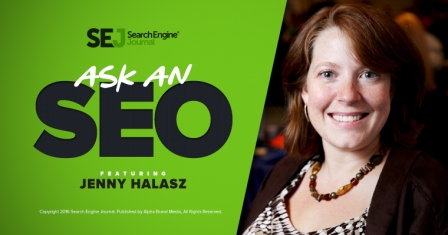
Want to ask Jenny an SEO question for her bi-weekly column? Fill out our form or use #AskAnSEO on social media.
Yet again, we’ve had a visitor ask a question that just can’t be answered in one paragraph, nor even one post. But I hope that this long treatment of the question will help clarify when you should and should not use nofollow on links.
What are the advantages and disadvantages of nofollow link?
 I think to answer this question; you have to understand a little bit of the history around the nofollow attribute. Google decided a few years ago that people were abusing links since they had made public that they were a part of the Google algorithm. Google singlehandedly decided to create this attribute. The idea was, you could use this attribute to signal to Google that you didn’t want them to count this link when they were evaluating your site’s inbound links.
I think to answer this question; you have to understand a little bit of the history around the nofollow attribute. Google decided a few years ago that people were abusing links since they had made public that they were a part of the Google algorithm. Google singlehandedly decided to create this attribute. The idea was, you could use this attribute to signal to Google that you didn’t want them to count this link when they were evaluating your site’s inbound links.
It was originally meant to be used for paid links, where you had control over the inbound link. Then Google started penalizing people for having too many links pointing to them that were deemed “unnatural”, such as directories, link exchanges, press releases, guest posts… it seems like every time you turn around now; there’s another link type you’re “supposed” to make nofollow.
What all this madness ignores is that links are the fundamental building blocks of the World Wide Web – born 25 years ago this year, in fact. Before search engines, the number one way people found new sites was by following links. But because the number one place most people start on the web now is a search engine (although it’s rapidly being overtaken by social and apps), Google feels perfectly at ease with dictating how we should link to each other.
As you can probably tell, I’m not a fan of this. I believe interactions should be natural; that sites that provide high-quality experiences and traffic should be able to link to anyone any way that they please. If your site doesn’t do these things, then you have other problems beyond what type of link attributes to use.
But I haven’t answered the question.
Nofollow links do not pass PageRank. Therefore, using a nofollow link means that link won’t pass PageRank (a Google-only measurement of the quantity and quality of links) to another page. This means, on the one hand, that Google cannot penalize you for linking to a site that’s known to be a low-quality site. They also can’t penalize you for linking out too much (yes, that’s actually happened). On the other hand, this also means that a link from your site bears no value to other sites, which means they’re much less likely to include you in announcements of new products or exciting developments unless you already have a very large user base.
Many of the largest sites like CNN and NFL now place nofollow on ALL their outbound links. This means that a link on their site has no value regarding PageRank. However, they still have value – very high value – because of the quality and size of their user base. Never forget, even a nofollow link has value, because it gives potential visitors the opportunity to visit your site and expands awareness. Even a mention on a site without a link is valuable for raising awareness.
All this sounds confusing because it is. There are no hard and fast rules to apply when deciding whether to link out to sites or not. However, I can provide you with a few good guidelines:
![]() Always nofollow links in comments or on forums. Anything that has user-generated content is likely to be a source of spam – even if you carefully moderate, things will slip through. I’ve fought back more than one manual action for UGC (User Generated Content) spam on some very reputable forums my clients’ manage. It slips through, even if you nofollow. But if you don’t nofollow, your spam-fighting will be much harder and more prevalent.
Always nofollow links in comments or on forums. Anything that has user-generated content is likely to be a source of spam – even if you carefully moderate, things will slip through. I’ve fought back more than one manual action for UGC (User Generated Content) spam on some very reputable forums my clients’ manage. It slips through, even if you nofollow. But if you don’t nofollow, your spam-fighting will be much harder and more prevalent.
![]() Always nofollow links that are meant to be advertisements or are in a sponsorship arrangement. This means sponsored content, text and image advertising, and run-of-site links.
Always nofollow links that are meant to be advertisements or are in a sponsorship arrangement. This means sponsored content, text and image advertising, and run-of-site links.
![]() Always nofollow links in press releases. They’ve just been over-used and abused too much. Most press release sites now nofollow all links by default anyway.
Always nofollow links in press releases. They’ve just been over-used and abused too much. Most press release sites now nofollow all links by default anyway.
![]() If you charge in any way for a link (directory submission, quality assessment, reviews, etc.), nofollow the outbound links.
If you charge in any way for a link (directory submission, quality assessment, reviews, etc.), nofollow the outbound links.
The difficulty comes in evaluating editorial links.
Allow Followed Links in These Cases:
![]() Bylines of authors for guest posters. This is only valid if your guest poster is someone you have vetted, who posts often on your site, and whose site is one that you trust. Even then, only allow your authors to include a single link, and only allow their anchor text to be their own name or their company name. The reason for doing this is that many reputable authors will prefer to post on sites that will offer them a link back to their company site in exchange for great content.
Bylines of authors for guest posters. This is only valid if your guest poster is someone you have vetted, who posts often on your site, and whose site is one that you trust. Even then, only allow your authors to include a single link, and only allow their anchor text to be their own name or their company name. The reason for doing this is that many reputable authors will prefer to post on sites that will offer them a link back to their company site in exchange for great content.
![]() Links to interviewees. If you are interviewing a celebrity or a subject matter expert, I think it’s fine to link to that person’s site. Again, only use anchor text (the linkable text) of their name or their company name to be safe, but providing a link in exchange for their time is the least you can do, and will help you score interviews with other important people in the future.
Links to interviewees. If you are interviewing a celebrity or a subject matter expert, I think it’s fine to link to that person’s site. Again, only use anchor text (the linkable text) of their name or their company name to be safe, but providing a link in exchange for their time is the least you can do, and will help you score interviews with other important people in the future.
![]() But be careful if you interview people every week, if you interview a lot of people who no one’s ever heard of, or if you interview someone who is known to practice shady link practices on their own site. Any of those situations might be one where you should nofollow the link.
But be careful if you interview people every week, if you interview a lot of people who no one’s ever heard of, or if you interview someone who is known to practice shady link practices on their own site. Any of those situations might be one where you should nofollow the link.
![]() Links in editorial content. If you are providing an unbiased, uncompensated review of a product or a tool, go ahead and link to that site. If you are citing another article as a source, link to that article. If you mention a positive association that you have with another site, go ahead and link to it. These are legitimate, editorial links. These sites deserve that link that you’re providing them.
Links in editorial content. If you are providing an unbiased, uncompensated review of a product or a tool, go ahead and link to that site. If you are citing another article as a source, link to that article. If you mention a positive association that you have with another site, go ahead and link to it. These are legitimate, editorial links. These sites deserve that link that you’re providing them.
![]() But be careful if you write a lot of review posts, if you receive something for free in exchange for reviewing it, or if you write a post only about one product or service without comparing it to others. These are all red flags for Google and they may begin to view your posts as “sponsored” content.
But be careful if you write a lot of review posts, if you receive something for free in exchange for reviewing it, or if you write a post only about one product or service without comparing it to others. These are all red flags for Google and they may begin to view your posts as “sponsored” content.
This is Not an Exhaustive List
Duane Forrester, formerly of Bing, once said that the only true link is the one you didn’t know you were going to get. While I think that’s somewhat naïve considering the many different types of link arrangements out there, I think it’s a good guideline for publishers. If you’re writing an article and the site you link to didn’t know you were going to mention them in advance, it’s probably just fine to keep that link follow-able.
I think it’s also fine if you decide to mention someone and you say to them ahead of time, “Hey, mind if I mention your idea in my article? I’ll give you credit.” You’ll see I’ve provided a link to Duane’s personal blog above. Since he’s no longer with Bing, it doesn’t make sense to link to them, but I want to give Duane credit. I don’t get to choose if SEJ allows it to be follow-able or not, but if I were writing this on my blog, it would be.
I’m sure this has made when to use nofollow (and when not to) about as clear as mud. My best advice for choosing is to be as natural as possible. If you want to link to the site and feel no pressure or obligation to do so, go ahead. If you’re getting money in exchange or you don’t think the site deserves the follow-able link, make it nofollow.
Image Credits
Featured Image: Image by Paulo Bobita
In-post Photo #1: Image by JLH Marketing. Used with permission.
Stop light images used under license from DepositPhotos.
(47)




